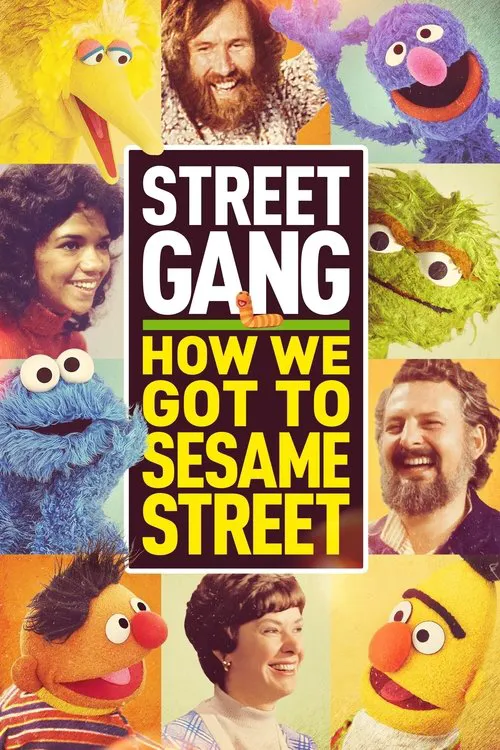Street Gang: How We Got to Sesame Street

Plot
In the 1950s and '60s, television was on the rise as a primary source of entertainment for families. The airwaves were filled with shows tailored to adult audiences, with little to no representation of young children. It was within this landscape that a group of visionary creators hatched a plan to revolutionize children's television. This narrative delves into the fascinating story of Sesame Street, one of the most influential children's shows in television history, and its impact on the world. At the helm of this creative movement was Joan Ganz Cooney and Lloyd Morrisett, two educators and television professionals who shared a passion for creating a program that would educate and engage young children. They approached the Carnegie Corporation with a proposal to develop a children's television show that would use entertaining and engaging formats to teach essential skills and values. The corporation saw the potential and backed their idea with a $1 million grant, paving the way for the birth of Sesame Street. Cooney and Morrisett assembled a talented cast of writers, producers, and artists to form the core team behind Sesame Street. Among these visionaries was legendary puppeteer Jim Henson, who would go on to create two of the show's most iconic characters: Big Bird and Cookie Monster. Henson's work with Frank Oz and the Muppets would play a significant role in shaping the tone and charm of the show. One of the driving forces behind Sesame Street was its emphasis on diversity and inclusivity. In an era where television rarely reflected the experiences of marginalized communities, the show's creators sought to break down barriers and create a welcoming environment for children from all walks of life. This mission led to the inclusion of characters such as Bob, a human cast member from the show's early days, and later, more iconic characters like Julia, who was designed to represent children with autism. Another key figure in the development of Sesame Street was writer and producer Joe Raposo. Raposo's work on the show's music and lyrics would become an integral part of its appeal, with memorable themes like "Sunny Day" and "C is for Cookie" cementing their place in popular culture. His collaborations with legendary artists like Joe Raposo and Jeff Moss resulted in catchy, engaging melodies that complemented the show's educational messages. Upon its debut in 1969, Sesame Street quickly gained popularity for its unique blend of education and entertainment. The show's use of lovable puppet characters, catchy music, and innovative storylines captivated both children and adults alike, setting a new standard for children's television. The characters, which have since become beloved by generations of kids, were expertly crafted to appeal to a wide range of ages and backgrounds, from toddlers struggling with basic arithmetic to older children facing challenges such as social anxiety and bullying. Beyond its iconic characters, Sesame Street also pioneered new approaches to education, using a multi-approach model that combined the arts, literacy, and social-emotional learning. Its emphasis on social-emotional learning, which was revolutionary at the time, laid the groundwork for the development of essential life skills, including empathy, self-awareness, and conflict resolution. As the years went by, Sesame Street continued to evolve, incorporating emerging issues and pressing social concerns into its educational programming. The show's handling of topics such as racism, inclusion, and environmentalism earned it widespread acclaim and recognition. Sesame Street became a cultural force, shaping the way we view and interact with children's entertainment. In 2019, the documentary series "Street Gang: How We Got to Sesame Street" was released, chronicling the show's groundbreaking history. This documentary offers an intimate glimpse into the world of Sesame Street, exploring the early brainstorming sessions, the creative development of its memorable characters, and the countless lives touched by the show's impact. Through the collective vision and determination of the pioneering team behind Sesame Street, the show has not only entertained generations of children but has also profoundly shaped the landscape of children's television. This iconic show has consistently demonstrated that entertainment can be a powerful tool for education, helping children to grow, learn, and develop essential skills that will serve them well throughout their lives. The power of Sesame Street extends beyond the screen, influencing social change and inspiring countless educators, artists, and creators to make a similar impact on the lives of others. The enduring legacy of this revolutionary show serves as a testament to the transformative potential of imagination, creativity, and the desire to make a meaningful difference in the world. As a landmark television show, Sesame Street embodies a profound understanding of the importance of education, entertainment, and social responsibility. It stands as a shining example of the potential for television to shape the world, inspiring generations of children to become curious, confident learners who are well-equipped to make a positive impact in their own communities.
Reviews
Recommendations




